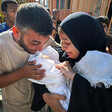Rights and Accountability 25 March 2016
Warning: this article includes very graphic video.
Israel’s political and military establishment broke out into a chorus of hypocritical condemnation after the release of a video showing a soldier shooting directly at the head of a Palestinian lying on the ground on Thursday.The military announced the detention of the soldier and the launch of an investigation into the killing.
The Palestinian man, Abd al-Fattah Yusri al-Sharif, was shot dead along with Ramzi Aziz al-Qasrawi, both of them 21, after allegedly stabbing and moderately wounding a soldier in the Tel Rumeida neighborhood of Hebron’s Old City in the occupied West Bank.
The Quds news site published photos showing al-Sharif (left) and al-Qasrawi:
The footage released by the Israeli rights group B’Tselem, which can be viewed at the top of this page, shows an Israeli soldier on a stretcher being transferred to an ambulance.Meanwhile, al-Sharif, already shot at least once, is seen lying on the ground, his head moving from side to side.
The video shows no attempt to give medical treatment to either of the wounded Palestinians yet there are two Israeli ambulances on the scene.
Numerous soldiers and Israeli settlers, some of them armed, are seen casually moving around, one of them filming the calm scene.
A voice is heard stating in Hebrew, “The terrorist is still alive, the dog,” and then, “The dog is still alive.”
At 1:48 into the video, a soldier cocks and aims his weapon, approaches al-Sharif, and shoots him. The video then shows blood streaming from the man’s head.
One of the ambulances is then seen circumnavigating around al-Sharif’s body. It slows down and a man is heard saying, “There is nothing to do, go.”
The Tel Aviv newspaper Haaretz reported: “The shooting was carried out while two officers stood nearby, and the two did not seem to respond to the incident. A few seconds before the shooting, they move aside and further away from the Palestinian who was lying on the ground. A voice can be heard saying ‘Okay, okay’ afterward. After a minute, the removal of the Palestinians’ bodies began.”
Several other videos of the incident have emerged.
This one, apparently taken by a Palestinian resident of the neighborhood, shows the two Palestinians lying wounded on the ground before ambulances responded to the scene.
A soldier commands the woman filming to return to her home as she protests, saying “This is my home!”
This video, taken from above, shows a soldier turning over the body of al-Qasrawi with his foot:
Another video, possibly recorded by the settler seen filming in the B’Tselem footage, shows al-Sharif before the camera pans over to al-Qasrawi: The man recording the video approaches al-Qasrawi and states in Hebrew, “Here is the knife, here is the terrorist.”The Hebrew watermark over the video reads “A Friend in Need,” a group which supports Israeli soldiers in Hebron.
In February, the group released a video showing the aftermath of the shooting of a 14-year-old Palestinian girl in the city. In the footage, a person from outside the camera’s view asks, “She’s not killed yet?” as the girl moans and writhes on the ground.
The wounded girl, Yasmin Rashad al-Zarou, was seriously wounded by soldiers who said she had attempted a stabbing attack – a claim denied by Palestinian witnesses.
Postures of condemnation
“What happened in Hebron does not represent the values of the Israel Defense Forces,” Benjamin Netanyahu declared after the emergence of B’Tselem’s video on Thursday.
Yet in November, B’Tselem pointed blame for the “the transformation of police officers, and even of armed civilians, into judges and executioners” squarely at Netanyahu.
“Your silence in the face of Minister of Public Security Gilad Erdan’s saying that ‘every terrorist should know that he will not survive the attack he is about to perpetrate’ is tantamount to consent to this unlawful policy,” B’Tselem said, addressing the Israeli prime minister.
Scenes like Thursday’s have become so commonplace throughout the occupied West Bank ever since a sharp increase in direct confrontation began in October, with approximately 200 Palestinians being shot dead since then, most of them during alleged attacks which have killed nearly 30 Israelis.
What’s exceptional about the apparent execution in Hebron is the widespread media coverage it received, and the promise of investigation by the military.
Videos showing Palestinians lying on the ground, seriously wounded, while soldiers and civilians stand by and no first aid is given, emerge week after week.
Other videos have caught soldiers, police and vigilantes shooting and killing Palestinians when they pose no immediate threat to anyone’s life – including schoolgirls.
Some videos show wounded Palestinians being taunted – even children – or beaten.
Others show Israeli forces shooting and killing subdued Palestinians at the urging of vengeful mobs.
Brigadier-General Moti Almoz, the Israeli army’s chief spokesperson, told Israel Radio, as reported by The New York Times, that “As far as the orders given to soldiers are concerned, the moment terrorists have been neutralized they are supposed to give medical treatment to the injured, even if they are terrorists.”
Yet in case after case, Palestinians are left to bleed to death in the street as Israeli soldiers refuse to administer treatment and prevent Palestinian medics from doing so.
In December, the Israel Medical Association’s ethics committee issued new guidelines calling on paramedics responding to alleged attacks to prioritize treatment according to the severity of injury, even if that means attending to an alleged attacker before his or her victims.
The association’s previous guidelines called for treating victims before alleged perpetrators, contrary to the principle of medical neutrality.
The new guidelines, which were drafted after a petition by Physicians for Human Rights-Israel, have been fiercely attacked, with Israel’s former foreign minister Avigdor Lieberman calling on the head of the medical association to resign.
Israel’s ZAKA volunteer emergency service said that it rejected the new guidelines.
The head of Magen David Adom, Israel’s national emergency service, said on Israeli radio at the time that its rule is “to treat the most seriously wounded person who is in life-threatening danger.”
Eli Bein added that “We treat the wounded, [but] if the security forces at the scene forbid our crew from treating a wounded person we don’t.”
Settlers in Hebron
Thursday’s incident in Tel Rumeida comes as Israel imposes closure on the West Bank and Gaza Strip, preventing movement in and out of the occupied territories, for the Jewish holiday of Purim.
As Ma’an reported, “Israeli settlers as well as other right-wing Israelis held celebrations in the Ibrahimi Mosque in Hebron’s Old City late Tuesday night ahead of the holiday.”
In 1994, a Jewish settler from Brooklyn killed 29 Palestinians and injured 125 as they worshipped in the mosque.
Following the massacre, Israel divided the mosque into Muslim and Jewish sections and closed the Shuhada Street commercial thoroughfare and other areas of Hebron’s Old City.
“Locals told Ma’an that during the celebrations, the settlers ‘provocatively’ used the mosque’s loudspeakers ‘to sing racist songs that call for the expulsion of ‘Arabs’ from Hebron.’”
Tel Rumeida is the site of one of five colonies in Hebron, where approximately 850 hostile settlers live within close quarters of Palestinians under the Israeli army’s guard.
Israel imposed severe movement restrictions on the neighborhood’s Palestinian residents at the end of October.
“You can’t move from one house to another without passing checkpoints or soldiers humiliating you. Even to leave the city is hard,” Tel Rumeida resident and Youth Against Settlements activist Issa Amro told The Electronic Intifada at the time.
The Palestinian rights group Al-Haq said that these and other measures were intended to push Palestinians out of the city.
Thursday’s incident is a grim illustration of the relationship between Israel’s settlers in Hebron, the army there to protect them, and the Palestinians who resist the colonization of their city.
“The shooting of a wounded and incapacitated person, even if they have been involved in an attack, has absolutely no justification and must be prosecuted as a potential war crime,” Philip Luther, director of Amnesty International’s Middle East and North Africa program, said on Thursday.
“While it is encouraging that the soldier in the video has reportedly been suspended and placed under investigation, previous Israeli investigations have failed to hold members of the Israeli forces accountable even when there has been clear evidence of criminal wrongdoing,” he added.
“The Israeli authorities must use this opportunity to end the culture of impunity that has made such killings increasingly commonplace.”
The blame should not stop there. It is Israel’s settler-colonial project itself which requires a brutal military occupation and ensures that such violence proliferates.
Noam Rotem contributed translation from Hebrew.






Comments
Impunity
Permalink Richard replied on
The fact that no soldiers or settlers react when the Palestinian is executed demonstrates that this murder is not exceptional. It is so common and impunity is so imbedded in the culture of occupation that no one flinches or reacts to the shooting in the head of a wounded Palestinian. In fact they film the murder on their phone.